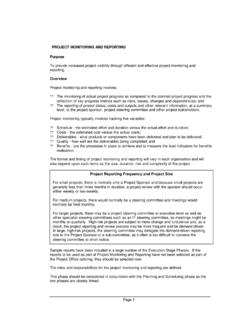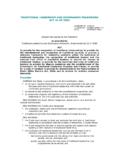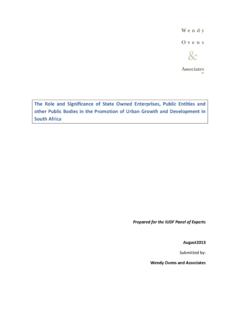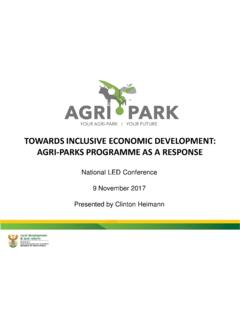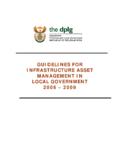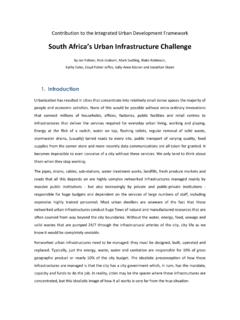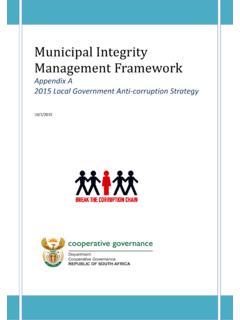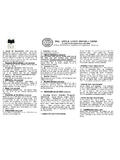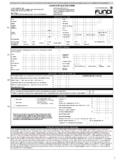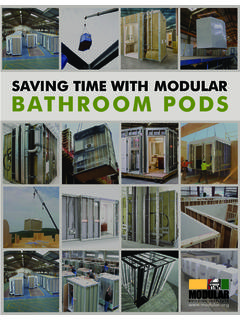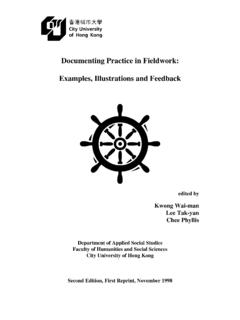Transcription of SPATIAL CONSIDERATIONS IN THE DEVELOPMENT …
1 1 SPATIAL CONSIDERATIONS IN THE DEVELOPMENT OF URBAN POLICY IN SOUTH AFRICA: A RESEARCH paper AS INPUT INTO THE PREPARATION OF THE INTEGRATED URBAN DEVELOPMENT FRAMEWORK (IUDF) Philip Harrison & Alison Todes1 1. Introduction This research report is a contribution to the preparation of an Integrated Urban DEVELOPMENT Framework (IUDF) for South Africa. It focusses explicitly on SPATIAL processes in South Africa s towns and cities, and should be read in the context of research papers dealing with other dimensions of urban DEVELOPMENT . The National DEVELOPMENT Plan (NDP) is a key departure point in the preparation of the IUDF: As part of implementing the National DEVELOPMENT Plan: Vision 2030, all three spheres of government in partnership with stakeholders need to manage the new wave of urbanisation in ways that also contribute to rural development2.
2 Chapter Eight of the NDP is the specific departure point for this research report as it deals with transforming human settlement and the national space economy . The Chapter gives strong emphasis to the importance of SPATIAL transformation in addressing concerns with poverty and inequality. It argues that where people live and work matters and that despite reforms to the planning system, colonial and apartheid legacies still structure space across different scales (RSA, 2012, ). The NDP provides an analysis of SPATIAL DEVELOPMENT in rural and urban areas, and offers a strategy to respond systematically, and over time, to entrenched SPATIAL patterns across all geographic scales that exacerbate social inequality and SPATIAL inefficiency ( ). This report does not repeat the content of the NDP, and should be read together with Chapter Eight.
3 The report does however seek to deepen and extend the analysis in Chapter Eight by drawing on data that became available subsequent to the writing of the Chapter; in particular, Census 2011. 1 The authors acknowledge the support of Miriam Maina, doctoral student at the University of the Witwatersrand, in the preparation of maps and in data analysis. 2 Terms of Reference for the Panel of Experts (POE) constituted to guide the preparation of IUDF (Section ). 2 This report focusses largely on data analysis. It does however begin with two contextual sections. First, it draws in international literature to argue that the core of urban SPATIAL policy in South Africa should be opening and expanding access to the benefits of living in towns and cities, especially proximity to jobs, to other livelihood opportunities, and to services and amenities.
4 Secondly, the report provides a brief account of transformations within the national space economy, showing that Apartheid barriers are breaking down and that population and economic activity is increasingly concentrating within the major urban centres in South Africa. The report then shifts to a detailed analysis of SPATIAL dynamics within mainly urban municipalities. A comprehensive account of these dynamics is impossible given the large number of municipalities, and the enormous diversity amongst municipalities. We have, however, attempted to provide a sense of the diversity and complexity by drawing on a cross-section of municipalities in different parts of the country, and at different scales. Mainly drawing on census data, but also including economic data from various sources, we analysed SPATIAL process in the City of Johannesburg, eThekwini Metropolitan Municipality (Greater Durban), Mangaung Metropolitan Municipality (Bloemfontein/Botshabelo), Polokwane Local Municipality, Mbombela Local Municipality (Nelspruit), King SabataDalindyebo (Greater Mthatha), Sol Plaatje (Kimberley), Knysna Local Municipality, and Greater Tubatse Local Municipality (Sekhukhuneland).
5 We explored trends including: population growth and decline; density changes; processes of racial segregation and desegregation; and changes in the space economy. The report relates these processes to the theme of access; in particular access for the urban poor. Particular attention is given to the role of inner cities, informal settlements, backyard rental, inclusionary housing policy and new transport investments in shaping access. Unsurprisingly, the picture is highly complex, and generalization from experience in one municipality is hazardous. However, we can conclude that far-reaching SPATIAL transformations are happening across South Africa s towns and cities, although at very different rates, and often taking different forms. Many of the SPATIAL trends are positive, bringing people and jobs/livelihood opportunities/services into a closer alignment.
6 However, these processes have generally happened because the barriers to mobility have been loosened with the collapse of statutory Apartheid rather than because of proactive government policies. There are also limits to certain of these processes. For example, the almost overwhelming demographic dominance of one race category black Africans in most places means that significant residential desegregation is unlikely, except in a few neighbourhoods. 3 SPATIAL processes which may be positive often have negative outcomes because they are poorly managed or facilitated by municipalities and other government authorities. Densification, for example, brings access to urban opportunities for increasing numbers of people. However, it also often happens together with slum formation, infrastructure overload and loss of valuable open space.
7 The report concludes with consideration to the instruments that the State has to facilitate positive transformations, and to guide existing processes towards better outcomes. 2. Access as a Key Objective for SPATIAL Transformation Access and its Co-Benefits SPATIAL integration has been a key objective in post-Apartheid SPATIAL planning, with policies to achieve this including densification and compaction of the urban fabric. This objective has been re-iterated through policy, legislation and plans, but the purpose of SPATIAL integration remains oddly vague and undefined. If the objective of SPATIAL integration was to achieve greater levels of social integration, then it has been pursued with little sense of urgency. Inclusionary housing policy, for example, was produced but legislation to implement the policy is still awaited.
8 Internationally, environmental objectives have often been at the heart of policies for urban integration and integration. There is little indication in South Africa that this was the driving factor in SPATIAL policy, although it has become increasingly important over time. In this report, we argue that the underlying rationale of post-Apartheid urban SPATIAL policy has, in fact, been to improve the access that the poor have to the urban advantage ; that is, to jobs, livelihood opportunities, urban services and other amenities. We argue that access should, indeed, be foregrounded as the key objective for SPATIAL transformation as it most directly links SPATIAL policy to key national objectives of eliminating poverty and reducing inequality (as indicated in the National DEVELOPMENT Plan, for example)3. However, careful attention should also be given to realizing the co-benefits of access; most importantly, social cohesion and environmental the early 1990sscholars have argued for co-evolutionary policies which bring together ideas of SPATIAL mobility (allocative efficiency), SPATIAL accessibility (distributional equity) and sustainable SPATIAL DEVELOPMENT 3 Chapter Eight of the NDP refers to the South African Constitution which affirms the right of all to a healthy environment; access to adequate housing; and access to basic services (Sections 24 of the National Constitution referred to RSA, 2012, ) [our emphasis].
9 4 (Himanen et al, 1992, ). In the South African context, policies to support greater SPATIAL access may also have the advantage of promotion greater levels of social integration and cohesion by producing a greater population mix4. Environmental sustainability is the other co-benefit as policies that produce better access to jobs, enhanced livelihood opportunities, reduced travel costs, and better household accessibility to services, may also support greater resource efficiency in households, reduce use of private motor cars, and more efficient use of land.(UN-Habitat, 2004) The major instruments supported internationally for improving greater access (with the co-benefits as mentioned) is greater urban density, or increased intensity of land use, promoted together with investments in public transport systems. There is however also a growing recognition that densification creates challenges that must be managed5 and must be promoted together with a set of complementary policies, and with consideration to the specificity of context.
10 UN-Habitat (2004, ) calls for policies and programmes to: Promote, preserve and open up natural spaces; integrate and retrofit infrastructure to support higher densities in appropriate locations; develop a sustainable urban transport strategy that focuses on non-motorized and public transport options; identify and intensify urban nodes; support nodes and public transit corridors; enhance the role of the street as a multi-functional urban space that accommodates a range of activities and uses; promote mixed-use DEVELOPMENT and intensification of activities; and, practice good governance, knowledge sharing and cooperative approaches. In the South African context, large cities are densifying rapidly, counter to an international trend (Angel et al, 2012), and so the question is less how to promote densification than how to leverage the benefits of densification to improve personal and household access to the urban advantage.

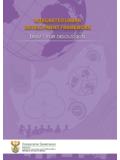
![Disaster Management Act [No. 57 of 2002]](/cache/preview/e/5/d/2/b/3/6/7/thumb-e5d2b36743b64ebe9204d7e874f734ad.jpg)
